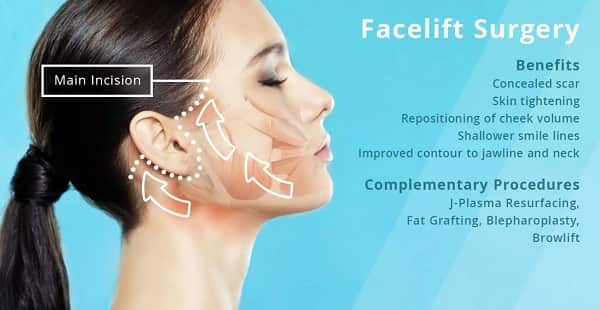Face lift surgery, also known as rhitedectomy, is a procedure that can be used to reverse the visual signs of aging such as drooping, thinning of the face, wrinkles, & folds of the face. Every individual has a unique set of facial characteristics and ages uniquely, exhibiting a variety of signs of aging.
The result is that face lift surgery is extremely customized for each individual since face lift surgery is more than simply skin stretching surgery; it also repositions the inside facial tissue in a much more youthful position. A brow lift & eyelid surgery to revitalize aging eyes is two procedures that may be performed in conjunction with face lift surgery to rejuvenate aging eyes.
An additional operation that will improve the effects of a face lift is fat transfer. This surgery may be recommended to replace lost fatty volume. Other procedures such as laser facial rejuvenation & deep peel are done to revitalize the skin.

Indian cosmetic surgery is of remarkable quality, and it is on par with the world standard in terms of treatment quality and safety. In India, the price of face lift surgery is regarded to be a portion of what this would cost to have the same procedure performed in the United States, the United Kingdom, Singapore, and other countries.
The expense of face lift surgery in India, combined with the expertise of cosmetic surgeons, makes it a desirable alternative. The cost of face lift surgery in India varies between Rs. 2,00,000 to 4,00,000 depending on the cosmetic surgeon chosen, the treatment performed, and the hospital or health facility chosen.
There are 7 different types of face lifts which include the following:
Face lift Neck elevator
Additionally, the neck elevator is activated, resulting in improved results for both your neck as well as the face game.
Upper face lift
The portion of the face between the cheekbones and the jowls remains targeted throughout this procedure. This results in the upper half of the face being formed.
Complete face lift
When you wish to tighten the skin all over your face, you might consider getting a total face lift. It is possible to touch up the skin on the neck to guarantee that there is no difference in the appearance of the skin.
S-face lift
Sagging skin all across the jawline and the top half of the neck is a sign that an individual is a good candidate for the S-lift procedure.
Classic neck elevator
When a person has sagging skin around the neck, they might undergo the time-tested neck lift procedure to restore a crisp and youthful neck form.
Lower neck & face lift
This procedure can be used to improve the appearance of one's face and neck, among other things.
Suture neck elevator
The epidermis of the neck has been contoured to give you a more youthful appearance. Individual tissue replaces this over time and remains in place.
Q1. What are the risks of having a facelift?
Ans: Facelifts in general do not constitute risks or side effects. However, in rare cases, there may arise situations like hematoma, scarring, and skin loss if not done properly. It is advised to get a facelift under the guidance of a good doctor.
Q2. How long will it take for your face to look normal after facelift surgery?
Ans: Generally, the recovery period will last till two to four weeks after which your face will look and give a normal feel. Also, you will need to understand that natural aging will happen and as such look to take care of your health and follow healthy lifestyle options going ahead.
Q3. How should I sleep after a facelift?
Ans: It is advised that after facelift surgery, a patient should sleep on their back and should keep their head at an elevated height with the use of pillows. This will help promote quicker healing and allow you to recover properly. Not only that this will also reduce the chances of swelling and any arising complications ahead.
Q4. What should I not do after facelift surgery?
Ans: You should avoid bending over or getting involved in activities like lifting heavy things for at least one week of your surgery. This needs to be done to avoid any rise in blood pressure in the facelifted area and to stop any swelling arising therein.
Q5. Can I smile after facelift surgery?
Ans: Yes, you can smile after your facelift surgery. However, you will feel slight tightness for a period of one to two weeks and have difficulty smiling properly. This will go down as the recovery continues and you can start smiling in your natural way.